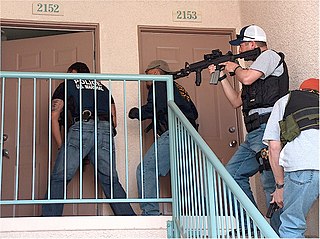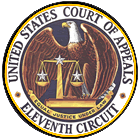
The Fourth Amendment to the United States Constitution is part of the Bill of Rights. It prohibits unreasonable searches and seizures and sets requirements for issuing warrants: warrants must be issued by a judge or magistrate, justified by probable cause, supported by oath or affirmation, and must particularly describe the place to be searched and the persons or things to be seized.
Mapp v. Ohio, 367 U.S. 643 (1961), was a landmark decision of the U.S. Supreme Court in which the Court ruled that the exclusionary rule, which prevents prosecutors from using evidence in court that was obtained by violating the 4th Amendment to the U.S. Constitution, applies not only to the federal government but also to the state governments. The Supreme Court accomplished this by use of a principle known as selective incorporation.

Search and seizure is a procedure used in many civil law and common law legal systems by which police or other authorities and their agents, who, suspecting that a crime has been committed, commence a search of a person's property and confiscate any relevant evidence found in connection to the crime.
Terry v. Ohio, 392 U.S. 1 (1968), was a landmark U.S. Supreme Court decision in which the court ruled that it is constitutional for American police to "stop and frisk" a person they reasonably suspect to be armed and involved in a crime. Specifically, the decision held that a police officer does not violate the Fourth Amendment to the U.S. Constitution's prohibition on unreasonable searches and seizures when questioning someone even though the officer lacks probable cause to arrest the person, so long as the police officer has a reasonable suspicion that the person has committed, is committing, or is about to commit a crime. The court also ruled that the police officer may perform a quick surface search of the person's outer clothing for weapons if they have reasonable suspicion that the person stopped is "armed and presently dangerous." This reasonable suspicion must be based on "specific and articulable facts," and not merely upon an officer's hunch.
Michigan v. Long, 463 U.S. 1032 (1983), was a decision by the United States Supreme Court that extended Terry v. Ohio, 392 U.S. 1 (1968) to allow searches of car compartments during a stop with reasonable suspicion. The case also clarified and narrowed the extent of adequate and independent state ground, allowing U.S. Supreme Court review of state supreme court decisions unless they explicitly appealed to state laws.
New Jersey v. T. L. O., 469 U.S. 325 (1985), is a landmark decision by the Supreme Court of the United States which established the standards by which a public school official can search a student in a school environment without a search warrant, and to what extent.
In the United States, the exclusionary rule is a legal rule, based on constitutional law, that prevents evidence collected or analyzed in violation of the defendant's constitutional rights from being used in a court of law. This may be considered an example of a prophylactic rule formulated by the judiciary in order to protect a constitutional right. The exclusionary rule may also, in some circumstances at least, be considered to follow directly from the constitutional language, such as the Fifth Amendment's command that no person "shall be compelled in any criminal case to be a witness against himself" and that no person "shall be deprived of life, liberty or property without due process of law."
Wolf v. Colorado, 338 U.S. 25 (1949), was a United States Supreme Court case in which the Court held 6—3 that, while the Fourth Amendment was applicable to the states, the exclusionary rule was not a necessary ingredient of the Fourth Amendment's right against warrantless and unreasonable searches and seizures. In Weeks v. United States, 232 U.S. 383 (1914), the Court held that as a matter of judicial implication the exclusionary rule was enforceable in federal courts but not derived from the explicit requirements of the Fourth Amendment. The Wolf Court decided not to incorporate the exclusionary rule as part of the Fourteenth Amendment in large part because the states which had rejected the Weeks Doctrine had not left the right to privacy without other means of protection. However, because most of the states' rules proved to be ineffective in deterrence, the Court overruled Wolf in Mapp v. Ohio, 367 U.S. 643 (1961). That landmark case made history as the exclusionary rule enforceable against the states through the Due Process clause of the Fourteenth Amendment to the same extent that it applied against the federal government.
In United States constitutional law and criminal procedure, the good-faith exception is one of the limitations on the exclusionary rule of the Fourth Amendment.
Katz v. United States, 389 U.S. 347 (1967), was a landmark decision of the U.S. Supreme Court in which the Court redefined what constitutes a "search" or "seizure" with regard to the protections of the Fourth Amendment to the U.S. Constitution. The ruling expanded the Fourth Amendment's protections from an individual's "persons, houses, papers, and effects", as specified in the Constitution's text, to include any areas where a person has a "reasonable expectation of privacy". The reasonable expectation of privacy standard, now known as the Katz test, was formulated in a concurring opinion by Justice John Marshall Harlan II.

Knock-and-announce, in United States law criminal procedure, is an ancient common law principle, incorporated into the Fourth Amendment, which requires law enforcement officers to announce their presence and provide residents with an opportunity to open the door prior to a search.
United States v. Leon, 468 U.S. 897 (1984), was a United States Supreme Court case in which the Court established the "good faith" exception to the Fourth Amendment exclusionary rule.
Hudson v. Michigan, 547 U.S. 586 (2006), is a United States Supreme Court case in which the Court held that a violation of the Fourth Amendment requirement that police officers knock, announce their presence, and wait a reasonable amount of time before entering a private residence does not require suppression of the evidence obtained in the ensuing search.
Arizona v. Evans, 514 U.S. 1 (1995), was a United States Supreme Court case in which the Court instituted an exclusionary rule exception allowing evidence obtained through a warrantless search to be valid when a police record erroneously indicates the existence of an outstanding warrant due to negligent conduct of a Clerk of Court.
United States Supreme Court cases titled Davis v. United States:
Ornelas v. United States, 517 U.S. 690 (1996), was a case decided by the Supreme Court of the United States that held that appellate courts should review probable cause determinations for warrantless searches de novo.
Florida v. Jimeno, 500 U.S. 248 (1991), was a U.S. Supreme Court case involving the exclusionary rule of evidence under the Fourth Amendment.

United States v. Quartavious Davis is a United States federal legal case that challenged the use in a criminal trial of location data obtained without a search warrant from MetroPCS, a cell phone service provider. Mobile phone tracking data had helped place the defendant in this case at the scene of several crimes, for which he was convicted. The defendant appealed to the Eleventh Circuit Court of Appeals, which found the warrantless data collection had violated his constitutional rights under the Fourth Amendment to the United States Constitution, but declined to order a new trial because the evidence was collected in good faith. The Eleventh Circuit has since vacated this decision pending a rehearing by the Eleventh Circuit en banc. United States v. Davis, 573 Fed. Appx. 925. On 5 May 2015, the en banc order upheld the use of the information. On 9th Nov 2015, the Supreme Court of the United States declined to hear this case on appeal.
Carpenter v. United States, 585 U.S. 296, 138 S.Ct. 2206 (2018), is a landmark United States Supreme Court case concerning the privacy of historical cell site location information (CSLI). The Court held that the government violates the Fourth Amendment to the United States Constitution when it accesses historical CSLI records containing the physical locations of cellphones without a search warrant.
Kimmelman v. Morrison, 477 U.S. 365 (1986), was a decision of the U.S. Supreme Court that clarified the relationship of the right to effective assistance of counsel under the Sixth Amendment to other constitutional rights in criminal procedure. In this case, evidence against the defendant was probably seized illegally, violating the Fourth Amendment, but he lost the chance to argue that point due to his lawyer's ineffectiveness. The prosecution argued that the defendant's attempt to make a Sixth Amendment argument via a habeas corpus petition was really a way to sneak his Fourth Amendment argument in through the back door. The Court unanimously disagreed, and held that the Fourth Amendment issue and the Sixth Amendment issue represented different constitutional values, and had different requirements for prevailing in court, and therefore were to be treated separately by rules of procedure. Therefore, the habeas corpus petition could go forward. In its opinion, the Court also gave guidance on how to apply its decisions in Stone v. Powell and Strickland v. Washington.




